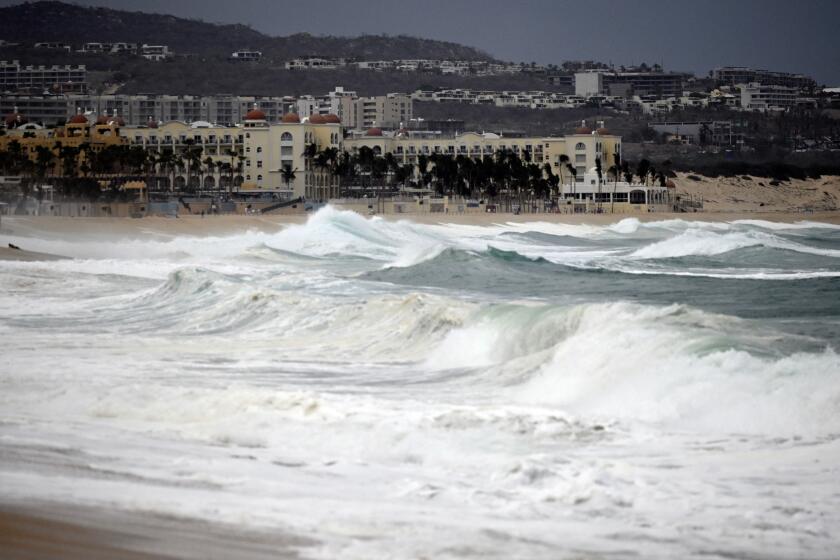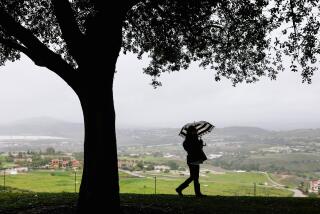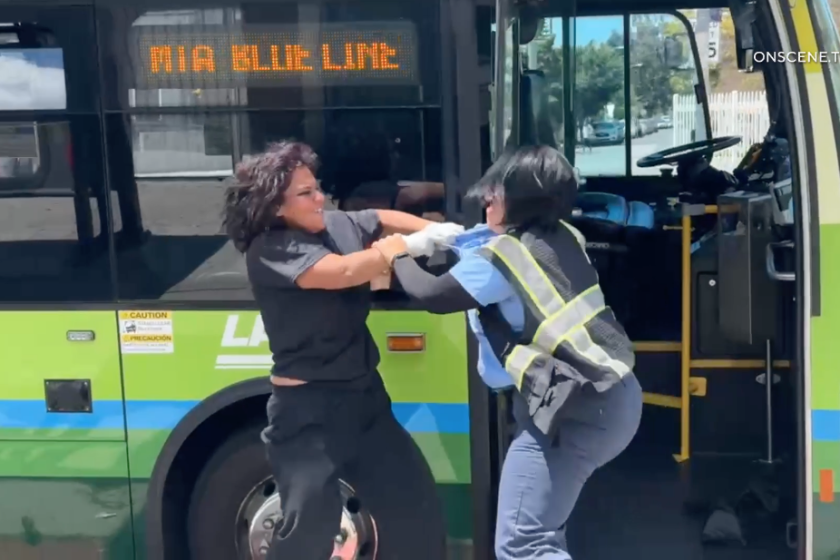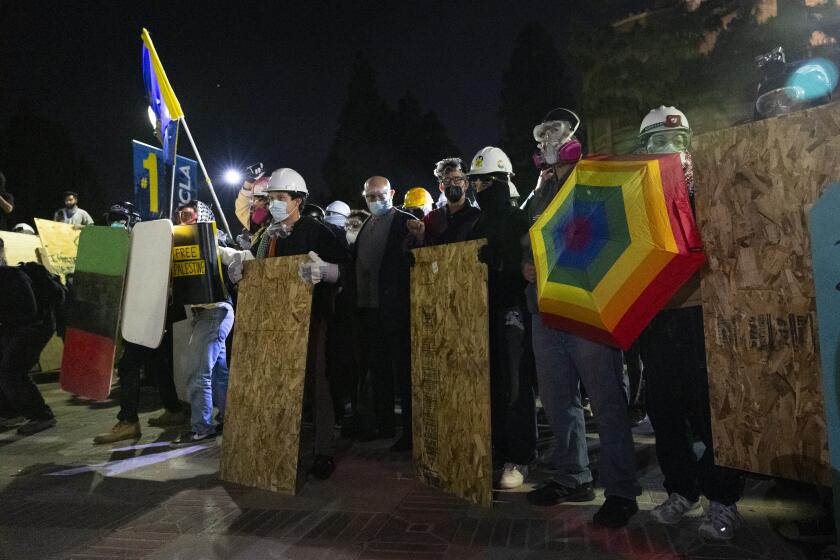Hurricane Hilary is coming. If you have to drive, here’s how to do it safely

If you’re like many Angelenos, you have even less experience driving on wet roads than you do driving on empty freeways.
But with Hurricane Hilary churning its way toward Southern California, the roads are soon going to be very wet. And that means driving will be extra hazardous — not only because of the slick pavement, but also because of the abundance of drivers who don’t know how to handle it.
Peter Jones, a spokesman for the California Department of Transportation, offered two pieces of advice for the weekend: “Avoid all nonessential travel,” he said, and “limit your time on the road during the peak of the storm, which is Sunday night to Monday.”
In particular, Jones said, avoid the Interstate 5 corridor, the Tejon Pass and the California Highway 14 corridor because “if the storm hits L.A., flooding is imminent there.”
Here are more tips for navigating storm-drenched roads safely.
Hurricane Hilary is likely to make landfall in Los Angeles as a tropical storm, bringing heavy rains and potential flooding. Here’s what you can do now to prepare, and how to stay safe when the storm arrives.
Check out the CalTrans Quickmap before heading out. Quickmap gives you updated information about road conditions, traffic, road closures and anything else you might need to know about the roads in California. If you don’t see what you need, call CalTrans at (213) 897-3656 or find the contact information for your district on its website.
For traffic updates on a specific route, you can also check CalTrans’ Road Information site or call 1-800-427-ROAD.
Be on the lookout for emergency vehicles. “If you do see emergency vehicles on the road, please move over because it gives the [California Highway Patrol] other emergency personnel and construction folks room to get through to handle the incident,” Jones said.
Do not drive on flooded streets. As little as 6 inches of water can cause cars to stall. Two feet of water can sweep a car off the road, including an SUV or pickup truck. If you see a pool of water, Jones said, “don’t drive in it because the water could be deeper than it appears.” This water can hide axle-breaking potholes and other dangerous road conditions. Stay updated on and respectful of all road closure notifications and instructions from emergency responders.
Support our journalism
This article on Hurricane Hilary is free for all readers. Support our journalism with a subscription to receive more storm coverage.
The National Weather Service’s “turn around, don’t drown” campaign warns people of the hazards of walking or driving a vehicle through flood waters. The Centers for Disease Control and Prevention reported that “over half of all flood-related drownings occur when a vehicle is driven into hazardous flood water. The next highest percentage of flood-related deaths is due to walking into or near flood waters.”
Hurricane Hilary is headed toward San Diego and L.A., with about a 50-50 chance tropical storm-force winds hit SoCal. What to know and how to stay safe.
Turn on your headlights. Under California law, if your windshield wipers are on because of inclement weather, your headlights must be too.
Drive slowly. Give yourself plenty of time to get to your destination, given the potential disruption of your usual route. Do not tailgate under any circumstances, as it takes longer to stop on wet roads. Abrupt stops may even result in hydroplaning, which will cause you to lose control of your car.
Don’t hit the brakes if you hydroplane. According to Progressive’s Life Lanes blog, the first thing to do is to “take your foot off the gas but don’t slam on the brakes,” because sudden braking can cause the car to spin even further out of control. Next, “gradually steer in the direction your car is hydroplaning.” Make sure that your tires match the direction of travel; this makes it easier for the vehicle to regain traction and stay under control when it gets its grip on the road. Lastly, “wait until you have control.” As the car starts to decelerate and pass through the wet patch, it will be easier to get traction on a dry part of the road.
High winds are creating unprecedented tropical storm conditions but officials emphasize that rain remains the greatest concern in Southern California.
Check your tires. Ensure that they are properly inflated and have enough tread depth to grip wet streets. The legal minimum is 2/32”, which is about the distance from the top of Lincoln’s head on a penny to the coin’s edge. For wet roads, though, some tire retailers and insurers recommend at least 4/32”, or about the distance from the top of Washington’s head on a quarter to the coin’s edge.
Make sure you have effective windshield wipers. Driversed.com says that “the general recommendation is to replace your windshield wipers every six to 12 months.” If you aren’t sure if it is time to replace them, look for these indicators: the rubber is damaged or hard and stiff to the touch; the wiper frame is bent; the wipers leave streaks on the windshield or skip across spots; or the wipers make clicking, chattering, squeaking, or vibrating sounds when in use.
Jones said Caltrans has workers available around the clock to answer calls and remove water from roads where there is flooding or potential flooding.
Rain weakens pavement and create or enlarge potholes. If your vehicle is damaged by potholes that are hidden by puddles during or after the storm, you may be able to obtain reimbursement from the government and your insurance company.
About The Times Utility Journalism Team
This article is from The Times’ Utility Journalism Team. Our mission is to be essential to the lives of Southern Californians by publishing information that solves problems, answers questions and helps with decision making. We serve audiences in and around Los Angeles — including current Times subscribers and diverse communities that haven’t historically had their needs met by our coverage.
How can we be useful to you and your community? Email utility (at) latimes.com or one of our journalists: Jon Healey, Ada Tseng, Jessica Roy and Karen Garcia.
More to Read
Start your day right
Sign up for Essential California for news, features and recommendations from the L.A. Times and beyond in your inbox six days a week.
You may occasionally receive promotional content from the Los Angeles Times.










